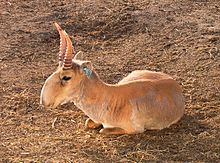Melliferous flora produce substances that can be collected by bees and turned into honey.
Photo: Prunus persicaplants
Whilst many plants are melliferous, only certain ones can be harvested by honey bees, those with the right physiognomy (body size, shape, length of proboscis etc.).
In Karakalpakstan there have been 206 species of wild vascular plants (which belong to 134 genera of 46 families} identified as having commercial value for beekeeping. Among those identified 196 species are also considered to have medicinal properties. Flowering of wild melliferous plants in Karakalpakstan starts from March some of the most common found include Populus nigraL., Roemeria refracta DC, Populus ariana Dode, Ferula foetida (Bunge) Regel, Ammodendron conollyi Bunge, Capparis herbacea Willd, Karelinia caspia (Pall.) Less, Halimodendron halodendron (Pall.) Voss, Fumaria vaillantii Loisel, Elaeagnus turcomanica N. Kozl, Elaeagnus oxycarpa Schlecht. Alhagi pseudalhagi (Bieb.) Fisch, Glycyrrhiza glabra L, Medicago sativa L.and Althaea armeniaca. After June, the bees start to collect honey from cultivated mellliferous species, such aswith cotton (Gossypium hirsutum L.), clover (Trifolium arvense L.), apricot (A. vulgaris Lam.), jiyda (Elaeagnus angustifolia L.), and peach [Prunus persica (L.) Batsch].
Whilst many plants are melliferous, only certain ones can be harvested by honey bees, those with the right physiognomy (body size, shape, length of proboscis etc.).
In Karakalpakstan there have been 206 species of wild vascular plants (which belong to 134 genera of 46 families} identified as having commercial value for beekeeping. Among those identified 196 species are also considered to have medicinal properties. Flowering of wild melliferous plants in Karakalpakstan starts from March some of the most common found include Populus nigraL., Roemeria refracta DC, Populus ariana Dode, Ferula foetida (Bunge) Regel, Ammodendron conollyi Bunge, Capparis herbacea Willd, Karelinia caspia (Pall.) Less, Halimodendron halodendron (Pall.) Voss, Fumaria vaillantii Loisel, Elaeagnus turcomanica N. Kozl, Elaeagnus oxycarpa Schlecht. Alhagi pseudalhagi (Bieb.) Fisch, Glycyrrhiza glabra L, Medicago sativa L.and Althaea armeniaca. After June, the bees start to collect honey from cultivated mellliferous species, such aswith cotton (Gossypium hirsutum L.), clover (Trifolium arvense L.), apricot (A. vulgaris Lam.), jiyda (Elaeagnus angustifolia L.), and peach [Prunus persica (L.) Batsch].
 Photo: Uztadbirkoreksport
Photo: Uztadbirkoreksport
The bee has been intricately woven into many cultures. Honey and honey based-products have a long tradition as a food source in Central Asia, with the hive and the honey produced nourishing the population for millennia. Once domesticated bees were actively farmed in time their pollination services became recognised as being of equal importance to their honey..

Photo: The main breed of honey bee in Uzbekistan is Apis mellifera carpathica. One of the important biological features of carpathian bees is their peaceful behaviour. This bee is winter hardy, which allows them to successfully come back from a long dormant periods.
Since ancient times honey has been used as a prophylactic food for treating many diseases. There are more than 150 traditional remedy's using honey, either in its pure form or mixed with various food ingredients (e.g., beet, pumpkin) which had strong medicinal and disease-preventive properties, especially those related to the respiratory system. Honey is known to be rich in both enzymatic and nonenzymatic antioxidants, including glucose oxidase, catalase, ascorbic acids, flavonoids, phenolic acids, carotenoid derivatives, organic acids, maillard reaction products, amino acids, and proteins. Through the use of enzymes, bees are able to convert the complex sugar in nectar into more simple sugars. Honey from melliferous flora has good antibacterial and preserving properties (up to 3 months at room temperature) and has long been used for improving human nutrition and boosting immunity. It contains many biologically active substances, as it is collected from many different species of plants. A more saturated honey it has good healing properties and is an important component of many drugs, dietary products, or cosmetics. Pure honey is used to treat coughs and colds. Furthermore, honey is used to prepare an ointment with other plant materials, which can be applied on various wounds as it has good antiseptic properties and prevents the growth of germs and bacteria. In addition, a mixture of honey, butter, and milk was used in the traditional treatment of tuberculosis and other respiratory diseases.

Photo: Karakalpakstan has very favourable conditions for beekeeping
In Karakalpakstan the production of honey from cultivated species such as cotton is most promising as it occupies a majority of the planted area. Currently the honey obtained from cotton flowers (Gossypium arboreum and Gossypium herbaceum) constitutes more than 50% of the total regional output. Honey from cotton is creamy with light amber colour and has a mild, pleasant, flowery taste, without excessive acidity. Karakalpakstan as in other parts of Uzbekistan there is an urgent need to preserve the melliferous flora that can sustain bee colonies via the continued conservation and preservation of the natural environment and biodiversity of flora. This will allow for the improvement and expansion of the apiary industry and ensure that it can continue to produce many tons of high-quality, environmentally friendly honey. Source:www.sciencedirect.com/science/article/pii/S2352618116300762





























